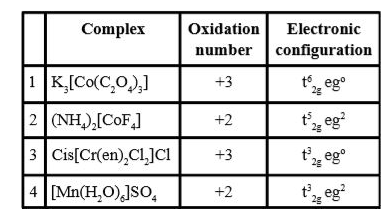Which of the following is/are inner orbital complex ?
[Fe(CN)6]4−
[Cr(NH3)6]3+
[Mn(CN)6]3−
All of these
The correct Answer is:D
To determine which of the given complexes are inner orbital complexes, we need to analyze each complex based on the oxidation state of the central metal ion, its electron configuration, and the hybridization involved. Inner orbital complexes involve the use of inner d orbitals in hybridization.
1. Identify the Complexes: The complexes given are:
- A) (Fe(CN)6)^(4-)
- B) (Cr(NH3)6)^(3+)
- C) (Mn(CN)6)^(3-)
2. Determine the Oxidation State and Electron Configuration:
- Complex A: (Fe(CN)6)^(4-)
- Let the oxidation state of Fe be x.
- The charge of CN is -1, and there are 6 CN ligands:
x+6(−1)=−4⟹x−6=−4⟹x=+2
- Iron (Fe) has an atomic number of 26, so its electron configuration is (Ar) 3d^6 4s^2.
- For Fe^2+, the configuration becomes (Ar) 3d^6 4s^0.
- In the presence of strong field ligands (CN^-), electron pairing occurs in the 3d orbitals. The hybridization is d^2sp^3, which involves the 3d orbitals. Thus, this is an inner orbital complex.
- Complex B: (Cr(NH3)6)^(3+)
- Let the oxidation state of Cr be y.
- NH3 is a neutral ligand, so:
y=+3
- Chromium (Cr) has an atomic number of 24, so its electron configuration is (Ar) 3d^5 4s^1.
- For Cr^3+, the configuration becomes (Ar) 3d^3 4s^0.
- NH3 is a weak field ligand, so no pairing occurs. The hybridization is also d^2sp^3, which involves the 3d orbitals. Thus, this is also an inner orbital complex.
- Complex C: (Mn(CN)6)^(3-)
- Let the oxidation state of Mn be z.
- The charge of CN is -1, and there are 6 CN ligands:
z+6(−1)=−3⟹z−6=−3⟹z=+3
- Manganese (Mn) has an atomic number of 25, so its electron configuration is (Ar) 3d^5 4s^2.
- For Mn^3+, the configuration becomes (Ar) 3d^4 4s^0.
- CN is a strong field ligand, which leads to electron pairing. The hybridization is d^2sp^3, which involves the 3d orbitals. Thus, this is also an inner orbital complex.
3. Conclusion: All three complexes involve the inner d orbitals in their hybridization. Therefore, the answer is:
- Option D: All of these are inner orbital complexes.
- A) (Fe(CN)6)^(4-)
- B) (Cr(NH3)6)^(3+)
- C) (Mn(CN)6)^(3-)
- Complex A: (Fe(CN)6)^(4-)
- Let the oxidation state of Fe be x.
- The charge of CN is -1, and there are 6 CN ligands:
x+6(−1)=−4⟹x−6=−4⟹x=+2
- Iron (Fe) has an atomic number of 26, so its electron configuration is (Ar) 3d^6 4s^2.
- For Fe^2+, the configuration becomes (Ar) 3d^6 4s^0.
- In the presence of strong field ligands (CN^-), electron pairing occurs in the 3d orbitals. The hybridization is d^2sp^3, which involves the 3d orbitals. Thus, this is an inner orbital complex.
- Let the oxidation state of Cr be y.
- NH3 is a neutral ligand, so:
y=+3
- Chromium (Cr) has an atomic number of 24, so its electron configuration is (Ar) 3d^5 4s^1.
- For Cr^3+, the configuration becomes (Ar) 3d^3 4s^0.
- NH3 is a weak field ligand, so no pairing occurs. The hybridization is also d^2sp^3, which involves the 3d orbitals. Thus, this is also an inner orbital complex.
- Let the oxidation state of Mn be z.
- The charge of CN is -1, and there are 6 CN ligands:
z+6(−1)=−3⟹z−6=−3⟹z=+3
- Manganese (Mn) has an atomic number of 25, so its electron configuration is (Ar) 3d^5 4s^2.
- For Mn^3+, the configuration becomes (Ar) 3d^4 4s^0.
- CN is a strong field ligand, which leads to electron pairing. The hybridization is d^2sp^3, which involves the 3d orbitals. Thus, this is also an inner orbital complex.
- Option D: All of these are inner orbital complexes.
Topper's Solved these Questions
- COORDINATION COMPOUNDS BOOK - AAKASH INSTITUTE ENGLISHCHAPTER - COORDINATION COMPOUNDS EXERCISE - Assignment (Section-B Objective type Questions (One Option is correct))
13 Videos
- COORDINATION COMPOUNDS BOOK - AAKASH INSTITUTE ENGLISHCHAPTER - COORDINATION COMPOUNDS EXERCISE - Assignment (Section-C Objective type Questions ( More than one Option are correct))
14 Videos
- COORDINATION COMPOUNDS BOOK - AAKASH INSTITUTE ENGLISHCHAPTER - COORDINATION COMPOUNDS EXERCISE - Try Yourself
14 Videos
- CLASSIFICATION OF ELEMENTS AND PERIODICITY IN PROPERTIESBOOK - AAKASH INSTITUTE ENGLISHCHAPTER - CLASSIFICATION OF ELEMENTS AND PERIODICITY IN PROPERTIESEXERCISE - Assignment (Section - J Aakash Challengers Questions)
6 Videos
- ELECTROCHEMISTRY BOOK - AAKASH INSTITUTE ENGLISHCHAPTER - ELECTROCHEMISTRY EXERCISE - Assignment (SECTION - J) (Aakash Challengers Questions)
10 Videos
Similar Questions
Which of the following is an inner orbital complex as well as diamagnetic in behaviour
[Atomic numbers Zn = 30, Cr = 24, Co = 27, Ni = 28.]
View SolutionWhich of the following is inner orbital complex as well as diamagnetic in nature ?
View SolutionWhich of the following is an outer orbital complex according to valence bond theory ?
View SolutionWhich one of the following is an outer orbital complex and exhibits paramagnetic behaviour ?
View SolutionAtomic number of Mn. Fe and Co are 25, 26 and 27 respectively. Which of the following inner orbital octahedral complex ions are diamagnetic ?
View SolutionWhich of the following outer orbital complex has the highest magnetic moment ?
View SolutionWhich of the following is not organometallic complex ?
View SolutionWhich of the following complexes is an inner orbtial complex ?
View SolutionWhich of the following complex is an outer orbital complex?
View SolutionWhich of the following is incorrectly matched complex?

View Solution
